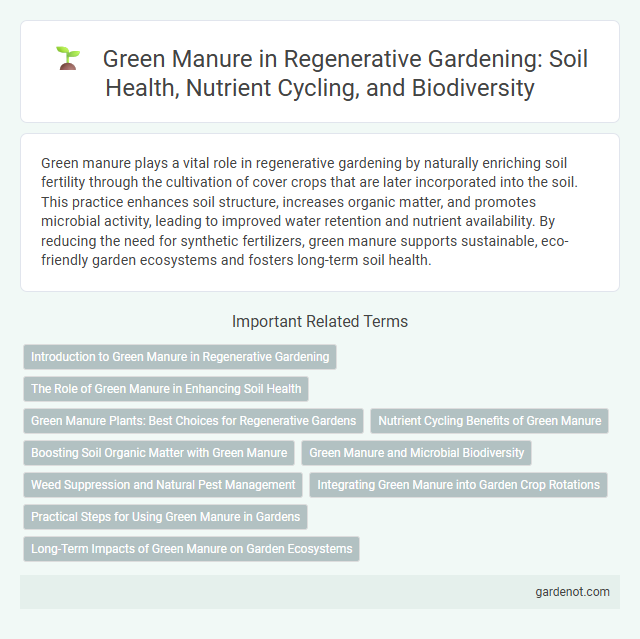Green manure plays a vital role in regenerative gardening by naturally enriching soil fertility through the cultivation of cover crops that are later incorporated into the soil. This practice enhances soil structure, increases organic matter, and promotes microbial activity, leading to improved water retention and nutrient availability. By reducing the need for synthetic fertilizers, green manure supports sustainable, eco-friendly garden ecosystems and fosters long-term soil health.
Introduction to Green Manure in Regenerative Gardening
Green manure involves growing specific cover crops such as clover, vetch, or rye to enrich soil health in regenerative gardening. These plants fix nitrogen, improve soil structure, and increase organic matter, enhancing microbial activity and nutrient availability for subsequent crops. Incorporating green manure reduces the need for synthetic fertilizers, promotes biodiversity, and supports sustainable soil regeneration.
The Role of Green Manure in Enhancing Soil Health
Green manure crops, such as clover and vetch, play a crucial role in enhancing soil health by increasing organic matter and improving soil structure. These plants fix atmospheric nitrogen, enriching soil fertility naturally and reducing the need for synthetic fertilizers. Incorporating green manure into regenerative gardens promotes microbial biodiversity and moisture retention, leading to more resilient and productive soil ecosystems.
Green Manure Plants: Best Choices for Regenerative Gardens
Green manure plants such as clover, vetch, and buckwheat are essential for improving soil fertility in regenerative gardens by fixing nitrogen and enhancing organic matter content. These plants suppress weeds, reduce soil erosion, and promote beneficial microbial activity, leading to healthier, more resilient gardens. Selecting green manure species suited to local climate and soil conditions maximizes nutrient cycling and overall garden productivity.
Nutrient Cycling Benefits of Green Manure
Green manure crops enhance nutrient cycling by fixing atmospheric nitrogen and enriching soil organic matter, which improves soil fertility and structure. They facilitate the efficient recycling of nutrients such as phosphorus and potassium, reducing the need for synthetic fertilizers. This process supports sustainable plant growth and long-term ecosystem health in regenerative gardens.
Boosting Soil Organic Matter with Green Manure
Green manure crops significantly enhance soil organic matter by decomposing biomass that enriches soil fertility and structure. Incorporating legumes like clover or vetch in regenerative gardens fixes atmospheric nitrogen, improving nutrient cycling and microbial activity. Increased organic matter from green manure boosts water retention and supports sustainable plant growth in diverse garden ecosystems.
Green Manure and Microbial Biodiversity
Green manure enhances soil fertility by increasing microbial biodiversity, which improves nutrient cycling and organic matter decomposition. Diverse microbial communities supported by green manure stimulate soil structure and promote plant health through natural disease suppression. Incorporating green manure crops like legumes enriches nitrogen levels, boosting beneficial microbes and fostering a resilient regenerative garden ecosystem.
Weed Suppression and Natural Pest Management
Green manure crops such as clover and vetch effectively suppress weeds by outcompeting them for light, nutrients, and space, reducing the need for herbicides in regenerative gardens. These cover crops also enhance natural pest management by attracting beneficial insects like ladybugs and predatory wasps, which feed on common garden pests. Incorporating green manure into soil management improves soil fertility and disrupts pest life cycles, contributing to a healthier, more resilient garden ecosystem.
Integrating Green Manure into Garden Crop Rotations
Integrating green manure into garden crop rotations enhances soil fertility by naturally fixing nitrogen and improving organic matter content. Cover crops such as clover, vetch, or rye are grown and then tilled into the soil to boost microbial activity and nutrient cycling. This practice reduces the need for synthetic fertilizers, promotes soil structure, and supports sustainable regenerative gardening systems.
Practical Steps for Using Green Manure in Gardens
In regenerative gardens, practical steps for using green manure include selecting nitrogen-fixing plants such as clover, vetch, or peas to improve soil fertility naturally. Sow green manure crops between main planting cycles and allow them to grow until flowering, then cut and incorporate them into the soil to enhance organic matter and support beneficial microbial activity. This method boosts soil structure, nutrient content, and moisture retention, promoting sustainable garden productivity.
Long-Term Impacts of Green Manure on Garden Ecosystems
Green manure significantly enhances soil fertility by increasing organic matter and nitrogen content, promoting nutrient cycling and microbial diversity in garden ecosystems. Over time, this practice improves soil structure, water retention, and resilience against erosion, fostering sustainable plant growth and biodiversity. Long-term use of green manure reduces dependency on synthetic fertilizers, contributing to ecological balance and healthier garden ecosystems.
Green manure Infographic

 gardenot.com
gardenot.com